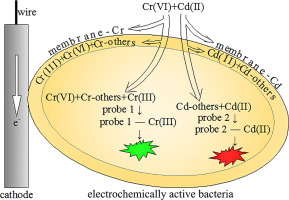Bioelectrochemistry ( IF 4.8 ) Pub Date : 2018-03-19 , DOI: 10.1016/j.bioelechem.2018.02.010 Liping Huang , Peng Zhou , Xie Quan , Bruce E. Logan

|
Electrochemically active bacteria (EAB) on the cathodes of microbial fuel cells (MFCs) can remove metals from the catholyte, but the fate of metals in the cells has not been examined in the presence of multiple metals. To study the relative uptake and fate of Cr(VI) and Cd(II) in cells, fluorescence probes were used to determine the amount and location of these metals in four different EAB on the biocathodes of MFCs. When both metals were present, less Cr(VI) was removed but Cd(II) uptake was not appreciably affected. As a consequence, the imaging of Cr(III) ions was lower than that using individual fluorescence probes for single Cr(III) ions in each EAB, compared to negligible changes in images for Cd(II) ions in the presence of either both Cr(VI) and Cd(II) or Cd(II) alone. The concentration of Cr(III) ions in the cells consistently increased over time, while that of Cd(II) ions decreased following an initial increase. Cr or Cd uptake could not be detected using a scanning electron microscope coupled with an energy dispersive spectrometer, reflecting the high sensitivities of the fluorescence probes to these metals. More chromium was found in the cytoplasm while cadmium preferentially accumulated in the cell envelope. These results demonstrate that the fate of chromium and cadmium in EAB was different when both metals were present, compared to controls containing a single metal. These results provide direct and visible results on the fate of the metals in the EAB when these metals are co-present in the catholyte of MFCs.
中文翻译:

从MFC的阴极电解液中去除二元Cr(VI)和Cd(II)并使用荧光探针确定EAB中它们的命运
微生物燃料电池(MFCs)阴极上的电化学活性细菌(EAB)可以从阴极电解液中去除金属,但是在存在多种金属的情况下,尚未检查电池中金属的命运。为了研究细胞中Cr(VI)和Cd(II)的相对摄取和命运,使用荧光探针确定MFCs生物阴极上四种不同EAB中这些金属的含量和位置。当两种金属都存在时,除去的Cr(VI)较少,但是对Cd(II)的吸收没有明显影响。因此,与在两个Cr均存在的情况下Cd(II)离子的图像变化可忽略不计相比,对于每个EAB中的单个Cr(III)离子而言,Cr(III)离子的成像均低于使用单个荧光探针进行的成像。 (VI)和单独的Cd(II)或Cd(II)。细胞中Cr(III)离子的浓度随时间不断增加,而Cd(II)离子的浓度随着初始浓度的增加而降低。使用结合能谱仪的扫描电子显微镜无法检测到Cr或Cd的吸收,这反映了荧光探针对这些金属的高敏感性。在细胞质中发现更多的铬,而镉优先积累在细胞膜中。这些结果表明,与包含单一金属的对照相比,当两种金属同时存在时,EAB中铬和镉的命运是不同的。当这些金属共存于MFC的阴极电解液中时,这些结果为EAB中金属的命运提供了直接可见的结果。使用结合能谱仪的扫描电子显微镜无法检测到Cr或Cd的吸收,这反映了荧光探针对这些金属的高敏感性。在细胞质中发现更多的铬,而镉优先积累在细胞膜中。这些结果表明,与包含单一金属的对照相比,当两种金属同时存在时,EAB中铬和镉的命运是不同的。当这些金属共存于MFC的阴极电解液中时,这些结果为EAB中金属的命运提供了直接可见的结果。使用结合能谱仪的扫描电子显微镜无法检测到Cr或Cd的吸收,这反映了荧光探针对这些金属的高敏感性。在细胞质中发现更多的铬,而镉优先积累在细胞膜中。这些结果表明,与包含单一金属的对照相比,当两种金属同时存在时,EAB中铬和镉的命运是不同的。当这些金属共存于MFC的阴极电解液中时,这些结果为EAB中金属的命运提供了直接可见的结果。在细胞质中发现更多的铬,而镉优先积累在细胞膜中。这些结果表明,与包含单一金属的对照相比,当两种金属同时存在时,EAB中铬和镉的命运是不同的。当这些金属共存于MFC的阴极电解液中时,这些结果为EAB中金属的命运提供了直接可见的结果。在细胞质中发现更多的铬,而镉优先积累在细胞膜中。这些结果表明,与包含单一金属的对照相比,当两种金属同时存在时,EAB中铬和镉的命运是不同的。当这些金属共存于MFC的阴极电解液中时,这些结果为EAB中金属的命运提供了直接可见的结果。











































 京公网安备 11010802027423号
京公网安备 11010802027423号